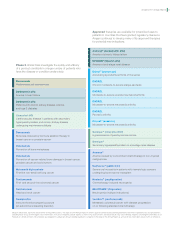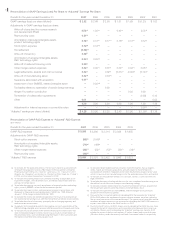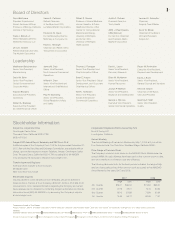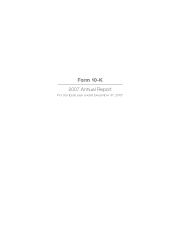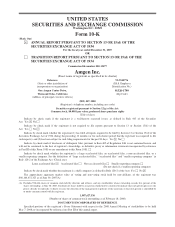Amgen 2007 Annual Report Download - page 17
Download and view the complete annual report
Please find page 17 of the 2007 Amgen annual report below. You can navigate through the pages in the report by either clicking on the pages listed below, or by using the keyword search tool below to find specific information within the annual report.Due to these regulatory developments, we and J&JPRD have taken further action since May 2007 in re-
sponse to recommendations by the FDA and ODAC, including:
• Issued Dear Healthcare Provider letters to communicate labeling changes
• Submitted Medication Guide and Instructions for Use (currently under review by FDA) to further inform
patients and enhance physician-patient discussion concerning the benefit:risk decision
• Along with Roche, engaged the Cochrane Collaboration, an independent international not-for-profit orga-
nization, to perform a patient-level combined analysis of all available controlled studies in ESAs in
oncology patients
• Collaborating with the National Cancer Institute and FDA on research activities to evaluate ESA therapy
in cancer
• Working with the FDA to design a large, definitive, well controlled study comparing the safety of ESAs
administered to a maximum Hb target of 12 g/dL per the product labeling versus placebo in three major
tumor types (non-small cell lung cancer (“NSCLC”), breast cancer and advanced colorectal cancer
(“CRC”))
We and J&JPRD are continuing to develop and implement a risk management and risk minimization plan to
address safety concerns regarding our ESA products. These activities include physician education, cancer patient/
patient advocacy group communications, implementation of a Medication Guide, tracking of risk communication
to patients, additional labeling changes and continuation of the ongoing pharmacovigilance and postmarketing
commitment (“PMC”) studies (see “Postmarketing and Safety Activities”).
In addition to these regulatory developments, there have been a number of reimbursement and related devel-
opments during 2007. For example, in February 2007, following the reported results from our AoC 103 study, the
United States Pharmacopoeia Dispensing Information (“USP DI”) Drug Reference Guides removed Aranesp®in
the treatment of AoC. Thereafter, Aranesp®use in AoC decreased significantly throughout 2007.
Additionally, on July 30, 2007, the Centers for Medicare and Medicaid Services (“CMS”) issued its Na-
tional Coverage Decision Memorandum for Use of Erythropoiesis Stimulating Agents in Cancer and Related
Neoplastic Conditions (the “Decision Memorandum”). The Decision Memorandum establishes the ESA re-
imbursement policy for Medicare and other government beneficiaries who are treated for chemotherapy-induced
anemia (“CIA”) and who all together accounted for approximately 50% of the U.S. cancer patients receiving
Aranesp®prior to its issuance. We believe that the majority of CIA patients who received treatment with ESAs,
including Aranesp®, were initiated at Hb levels above 10 g/dL and were maintained with Hb levels above 10 g/
dL with continued therapy prior to the issuance of the Decision Memorandum. Given that the Decision Memo-
randum contains a coverage restriction for Hb levels greater than 10 g/dL, we believe that such restriction has
and will continue to change the way ESAs are used in clinical practice, for example, by decreasing the number of
treated patients, the average ESA dose and the duration of ESA therapy. We believe this restriction on
reimbursement of ESAs in the Decision Memorandum has had and will continue to have a material adverse effect
on the use, reimbursement and sales of Aranesp®. Additionally, based on our knowledge, although no private
payers have implemented the Decision Memorandum to date, many private payers have implemented the Hb ini-
tiation restriction included in the Decision Memorandum. Further, due to difficulties in administering a two-tier
medical practice, we believe many healthcare providers have reduced ESA utilization for all of their patients re-
gardless of insurance coverage. On January 14, 2008, CMS issued changes to its Medicare National Coverage
Determinations Manual, adding to the ESA Decision Memorandum, which provides instructions to local Medi-
care contractors with respect to the implementation of the Decision Memorandum. Local Medicare contractors
have until April 7, 2008 to implement the instructions, although the effective date of the Decision Memorandum
is for claims with dates of service on or after July 30, 2007. We continue to evaluate the Decision Memo-
randum’s impact on use, reimbursement and sales of Aranesp®, and on our business and results of operations.
On November 13, 2007, we submitted new evidence to the CMS to support a formal request for reconsidera-
tion of their Decision Memorandum on ESAs. In this request, we stated that we are supportive of most aspects of
the Decision Memorandum and are requesting a very narrow reconsideration of a specific provision in the policy.
5


